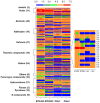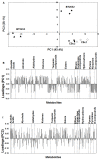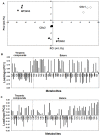Exploring the Saccharomyces cerevisiae Volatile Metabolome: Indigenous versus Commercial Strains
- PMID: 26600152
- PMCID: PMC4657929
- DOI: 10.1371/journal.pone.0143641
Exploring the Saccharomyces cerevisiae Volatile Metabolome: Indigenous versus Commercial Strains
Abstract
Winemaking is a highly industrialized process and a number of commercial Saccharomyces cerevisiae strains are used around the world, neglecting the diversity of native yeast strains that are responsible for the production of wines peculiar flavours. The aim of this study was to in-depth establish the S. cerevisiae volatile metabolome and to assess inter-strains variability. To fulfill this objective, two indigenous strains (BT2652 and BT2453 isolated from spontaneous fermentation of grapes collected in Bairrada Appellation, Portugal) and two commercial strains (CSc1 and CSc2) S. cerevisiae were analysed using a methodology based on advanced multidimensional gas chromatography (HS-SPME/GC×GC-ToFMS) tandem with multivariate analysis. A total of 257 volatile metabolites were identified, distributed over the chemical families of acetals, acids, alcohols, aldehydes, ketones, terpenic compounds, esters, ethers, furan-type compounds, hydrocarbons, pyrans, pyrazines and S-compounds. Some of these families are related with metabolic pathways of amino acid, carbohydrate and fatty acid metabolism as well as mono and sesquiterpenic biosynthesis. Principal Component Analysis (PCA) was used with a dataset comprising all variables (257 volatile components), and a distinction was observed between commercial and indigenous strains, which suggests inter-strains variability. In a second step, a subset containing esters and terpenic compounds (C10 and C15), metabolites of particular relevance to wine aroma, was also analysed using PCA. The terpenic and ester profiles express the strains variability and their potential contribution to the wine aromas, specially the BT2453, which produced the higher terpenic content. This research contributes to understand the metabolic diversity of indigenous wine microflora versus commercial strains and achieved knowledge that may be further exploited to produce wines with peculiar aroma properties.
Conflict of interest statement
Figures






References
-
- Romano P. Metabolic characteristics of wine strains during spontaneous and inoculated fermentation. Food Technol Biotechnol. 1997;35: 255–260.
-
- Lambrechts M, Pretorius I. Yeast and its importance to wine aroma—a review. South African J Enol Vitic. 2000;21: 97–129.
-
- Pretorius IS. Tailoring wine yeast for the new millennium: novel approaches to the ancient art of winemaking. Yeast. 2000;16: 675–729. - PubMed
-
- Romano P, Monteleone E, Paraggio M, Marchese R, Caporale G, Carlucci A. A methodological approach to the selection of Saccharomyces cerevisiae wine strains. Food Technol Biotechnol. 1998;36: 69–74.
-
- Swiegers JH, Bartowsky EJ, Henschke PA, Pretorius IS. Yeast and bacterial modulation of wine aroma and flavour. Aust J Grape Wine Res. 2005;11: 139–173.
Publication types
MeSH terms
Substances
LinkOut - more resources
Full Text Sources
Other Literature Sources
Molecular Biology Databases

